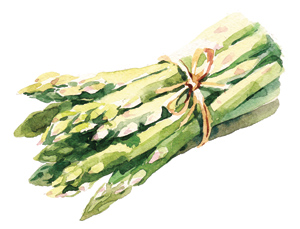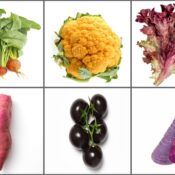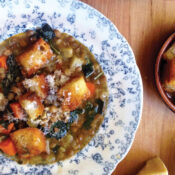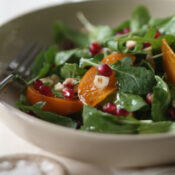Naturalist Euell Gibbons wrote the 1962 bestseller Stalking the Wild Asparagus, which struck a chord with the burgeoning back-to-nature movement — and made him a celebrity. He learned about wild edibles from his mother, and at 11 years old, foraged for local plants and berries in New Mexico to supplement the family’s diet. Many remember his guest appearances on The Tonight Show and The Sonny & Cher Comedy Hour, as well as his role as spokesperson for Grape-Nuts commercials (“Tastes like wild hickory nuts”). In 1964, the Post joined the outdoorsman as he foraged “wild” foods for lunch near his farm in Pennsylvania.
Stalking the Weed Eater
Originally published on July 25, 1964

On a cloudy morning recently a tall, weatherbeaten man in his early 50’s sloshed around in a swamp near Beavertown, Pennsylvania, yanking weeds out of the mud and eating them. As he munched, he kept up an enthusiastic running commentary. “Look at these cattails!” he cried. “Just perfect! I can smell calamus all around me! Here’s my lunch! Right here!”
The speaker was not a fugitive from the local asylum, but a thoroughly sane gentleman who ranks as an authority on the neglected art of living off the land. His name is Euell Gibbons. He has made a lifelong study of wild food, foraging through many of the 50 states for a wide variety of flora and fauna, which he fearlessly pops into the pot.
He is “a born cook,” says Craig Claiborne, food editor of The New York Times, “who improvises with authority and imagination.” His culinary adventuring — which he has chronicled in two unusual and instructive books, Stalking the Wild Asparagus and Stalking the Blue-eyed Scallop (published last month by David McKay) — has made him a celebrity in certain back-to-nature circles, and has caused other citizens to tap their foreheads. His notoriety amuses Gibbons — up to a point. “I don’t mind being called ‘the weed eater,’” he says, “because that’s accurate — I do eat weeds, and a lot of other things people consider strange. But I object when they imply I’m some kind of freak, like the men in sideshows who eat beer glasses. I just enjoy the experience of gathering my own meals, free. It gets me back to the fundamentals.”
Gibbons continued to collect handfuls of the calamus and cattails, tucked them into plastic bags, and then headed across a field toward the road, where his beat-up ’53 Chevy panel truck was parked.
“Calamus is sometimes called sweet flag,” he said, as he churned along in his hip boots. “It has a spicy aroma, and adds a lot to a wild salad. Cattails are the supermarket of the swamps. You can get six kinds of first-class food out of them. Americans don’t eat them because of illogical food prejudice — the same nonsense that makes them shy away from good foods like milkweed, Jerusalem artichokes, pigweed. Pigweed is really delicious.”
Halfway across the field Gibbons reached a spring that was thickly overgrown with small, dark green leaves. “Wild watercress,” he said. He sampled the leaves, trimmed off a bagful with a penknife, then moved on, pointing out where wild strawberries, dewberries, and wild grapes would show up later in the season. He indicated a cluster of slender six-foot stalks topped by flame-shaped, dark red heads. “That’s sumac,” he said. “We make a drink like pink lemonade by pounding the acid out of the heads. It’s hard work, but Ronald, the older of my two sons — he’s 27 now, and is in the Air Force — discovered a shortcut. He put the heads and water in the washing machine for ten minutes, then caught the mixture when it was pumped out.”
When he reached his truck, Gibbons switched from boots to sneakers and slid behind the wheel. As he drove, he jerked a thumb at half a dozen other places where he does his marketing — patches of spiky pale-green day-lily shoots, clumps of wild onion, a black-walnut tree. “I’ve found,” he said, “that foraging is far more productive in this country than in the South Pacific. The variety is wider here. There’s decent foraging in most suburbs, and you can even find wild foods in the city. Not long ago I spotted four different kinds near Rockefeller Center in New York. The best foraging is along the seashore in summer. You get the usual inland plants, plus fish, oysters, clams, crabs, lobsters, mussels, and plants like glasswort, sea blite, goosetongue, and scurvy grass. Did you know that periwinkles are marvelous eating? Except in the dead of winter, you can collect a week’s supply of wild food in one afternoon almost anywhere in the U.S. But most people go to the supermarket and pay good money for tasteless stuff that’s been shipped halfway across the continent. That’s the way we live today — secondhand or thirdhand.”
Observations of this kind crop up periodically in Gibbons’ conversation. He has a deeper-than-average vein of philosophy in him — which may explain the fact that he and his wife, Freda, became Quakers a few years ago. He is especially concerned with what he calls the “high price we have paid for our plenty.” He believes that people need to feel that they are “more than a mere mechanical part of an intricately interdependent industrial system.” For him, foraging is a “creative protest against the artificiality of our daily lives.” When he makes a statement like “Some of the most precious moments of my life have been spent picking wild strawberries,” he means every word.
Gibbons learned his love of foraging from his mother, who often supplemented the family’s larder with wild food. He was born in the Red River Valley in Texas, and spent his boyhood on a homestead in the hill country of New Mexico. When he was 13, his family was hit by a series of calamities — drought, loss of credit, the death of their livestock — and Gibbons’ father had to leave home to find work.
The family knew no neighbors they could turn to, and weren’t being helped by welfare agencies. They exhausted supplies, except for a sack of pinto beans and one egg. “None of us would eat the egg,” Gibbons explains, “because that would have meant depriving the others. I tried to give it to my sister, she tried to give it to my brother. That uneaten egg was the symbol of our humanity toward one another.” After weeks of the all-bean diet, they began vomiting as soon as they swallowed, and Mrs. Gibbons became ill from malnutrition. In desperation, Gibbons scoured the surrounding desert for wild potatoes, puffballs, pition nuts, prickly pear, and rabbits. The family’s health improved; Gibbons’ father landed a job, and rescued them by wiring money. Gibbons talks about the ordeal with calm, but it obviously had a deep effect on him.
In later years Gibbons shifted around the United States and the South Pacific, working as cowboy, boatbuilder, teacher, newspaperman, carpenter, farmer, and beachcomber. He is currently a full-time writer. In Hawaii he met Freda, a teacher who was born near Philadelphia.
Before their marriage Gibbons didn’t bother to mention his passion for foraging. “The subject just never came up,” he explains. “I guess I was more interested in courting her.” Later, when he began bringing home bales of plant life, Freda found the situation “pretty gruesome,” but she learned to put up with it. Gibbons introduced both his sons to foraging at an early age. For the younger one — Mike, now a 25-year-old electrician — it cleared up some childhood eating problems. Mike liked very few foods, but when he went foraging with his father, the spirit of the chase took over, and he began enjoying the food.
Gibbons admits that many of his experiments are failures. “I’ve served up some nauseous messes,” he said as he continued driving through the rolling farmland. “When that happens, I open a can of something. Freda and the boys have been very patient. I don’t just run through the woods and graze, however. You have to know what you’re doing when you go foraging.”
Gibbons’ lunch menu that day called for two wild vegetables to go with the entree — catfish, which he had caught in a nearby pond. At the foot of a hill he uprooted young dandelions, and near a shallow ditch he found Barbarea verna,which looks like a cross between spinach and lettuce and is commonly called winter cress. “Most gardeners treat these like weeds — they throw them on the compost heap. A weed is just a plant growing where someone doesn’t want it to grow. I used to keep a garden, but I got most of my food from between the rows.”
By noon Gibbons was fixing lunch in the kitchen of his roomy, white-frame house, named “It Wonders Me.” He prepared the dandelions by slicing the greens and roots away and keeping the pale green inner crowns, boiled the Barbarea, and fried the catfish fillets in tempura batter. While he worked, he talked.
“There seems to be increasing interest in wild foods,” he said. “I think it’s partly because we’re survival-conscious. Also the population explosion has started scientists thinking about food sources. Wild foods could be a partial answer to impoverished areas of this country. In Appalachia, for example, there are dozens of fine, free foods just waiting to be harvested. People are afraid they’ll be looked down on if they gather them.”
Gibbons served lunch around 1:30. Before digging in, the family bowed their heads for a moment of silence — what Freda calls a “quiet time.” The first few mouthfuls made it clear why Gibbons has been hailed as a gourmet. For cocktails — Gibbons is a nondrinker — there was wild-grape juice. The catfish fillets were fresh and delicate. The dandelion crowns had some of the flavor and crisp texture of artichoke hearts. Gibbons had sprinkled bacon on the Barbarea, which tasted like a countrified relative of broccoli. To make bright yellow muffins, Gibbons had used cattail pollen mixed with ordinary flour and preserved wild shadberries. There were three kinds of wild-fruit jam, including one that combined blueberries, shadberries, and raspberries. The salad was a potent blend of seven wild ingredients: watercress, sheep sorrel, day-lily shoots, onions, mint, cattail sprouts, and calamus stalks. Dessert was a fluffy persimmon-and-hickory nut pie, followed by candied wild ginger.
When the last of it had been washed down with sassafras tea, Gibbons lit his pipe and revealed that he had used 20 different wild plants in all, and only a handful of store-bought items. He estimated the total cost at 50 cents.
“Economy is one of the great attractions of wild food,” he said, “but it’s a lot of hard work. I don’t do this every day. We have one or two wild dishes with each meal. I freeze and can many wild things. We call meals which are 100 percent wild our ‘wild parties.’
“I think the biggest attraction of wild food,” Gibbons added, “is the feeling that you’re reaping from nature. A couple of years ago Freda and another couple and I spent a week in a cabin deep in the woods. We took just enough food for the first breakfast, and foraged the rest. That vacation cost less than four dollars, and it gave us a fine feeling to know we could walk into a wilderness and live well. We’ll remember it all of our lives. Especially my friend’s wife. She gained five pounds.
“After my first book was published,” Gibbons went on, “I got letters saying how important contact with nature is. One woman said, ‘If things go on the way they are, people will soon believe that on the first day of creation, a can was opened, and out came the world.’ One thing I believe very strongly: We should stop talking about ‘conquering nature.’ The really civilized people are those who can learn to live with nature.”
After lunch Gibbons walked his guests down the driveway and pointed to the crabgrass. “Proving it’s edible would be quite something, don’t you think? I’m working on it.”
Interested in learning more? Find how-to’s, classes, and tours across the U.S. at saturdayeveningpost.com/foraging.
Become a Saturday Evening Post member and enjoy unlimited access. Subscribe now


